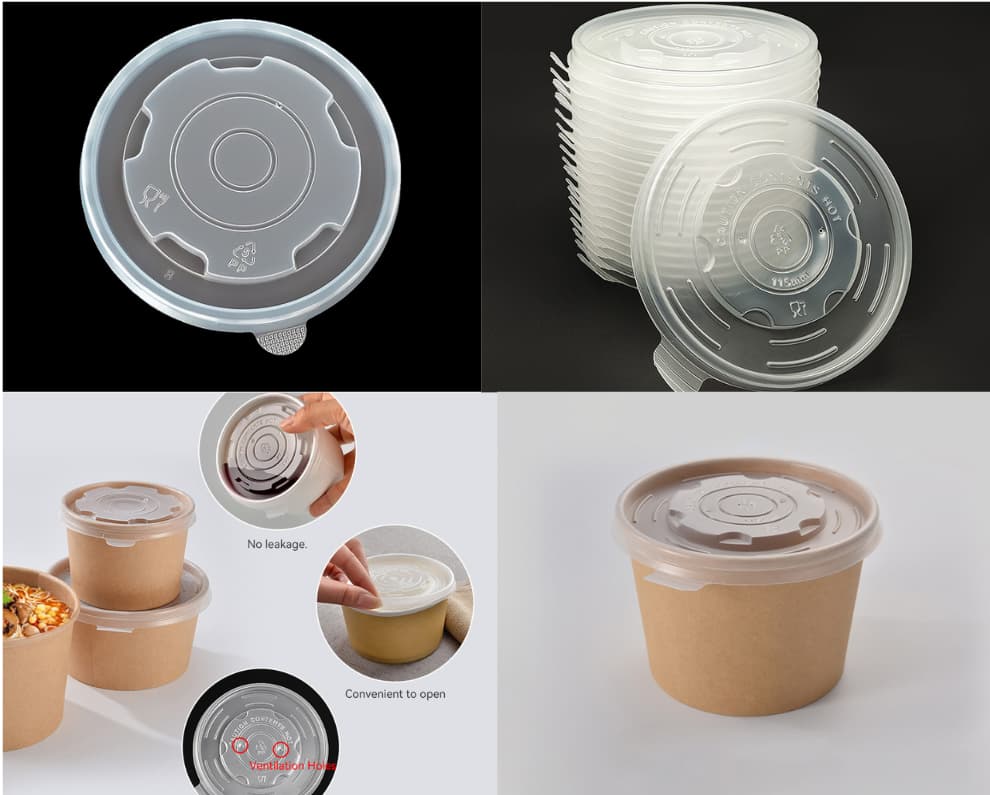Introduction
In today’s foodservice and delivery industry, customers demand leak-proof packaging that guarantees safety and convenience. A single spill can damage brand trust and lead to costly refunds. But what makes a cup or container truly leak-proof?
It’s a combination of engineering design, sealing technology, and the right material. In this article, we’ll dive deep into the science behind leak-proof packaging and introduce industry-proven models for both hot and cold applications.
Why Do Packaging Leaks Happen?
Common reasons include:
- Poor lid-to-container fit causing gaps
- Material deformation under heat or pressure
- Weak sealing design, especially with liquids
- Vibrations during delivery that break loose lids
Leak-proof packaging solves these issues through advanced mechanical locking, sealing grooves, and structural reinforcements.
Core Leak-Proof Technologies
✅ 1. Snap-Fit Lock Design
A 360° interlocking rim system creates a tight seal, preventing leaks even when containers are shaken or tilted.
✅ 2. Double-Sealing Edge for Boxes
Food containers feature inner locking grooves and raised rims to keep sauces and liquids inside.
✅ 3. Heat-Resistant PP for Hot Meals
Polypropylene (PP) resists deformation under heat, making it ideal for soups and microwave use.
✅ 4. Dual-Layer Dome Lids for Drinks
PET cups with precision dome lids ensure anti-spill performance for iced drinks and smoothies.
✅ 5. Ultrasonic & Heat Sealing for MAP Packaging
Used in ready-to-eat meals and soups, this process ensures airtight security and tamper-evidence.

Popular Leak-Proof Packaging Models
| Category | Material | Common Sizes | Features |
|---|---|---|---|
| Soup Containers | PP | 500ml / 750ml / 1000ml | Microwave-safe, snap-fit lid |
| Lunch Boxes | PP | 2-Comp / 3-Comp | Leak-proof lock rim, strong hinges |
| Drink Cups | PET | 12oz / 16oz / 24oz | Dome lid, anti-spill straw slot |
| MAP Meal Trays | PP / CPET | 1-4 Compartment | Heat-sealed film, tamper-proof |
Advanced Sealing Technologies Compared
| Method | Applications | Advantages |
|---|---|---|
| Snap-Fit | Cups & Lunch Boxes | Easy to use, reusable |
| Ultrasonic Sealing | Ready Meals | Airtight, high-speed production |
| Heat Sealing | MAP Trays & PP Boxes | Leak-proof, cost-effective |
FAQs: Leak-Proof Packaging Explained
Q1: Are leak-proof cups suitable for carbonated drinks?
Yes, PET cups with reinforced dome lids can handle internal pressure.
Q2: Which material is best for hot soups?
PP is ideal for hot food due to heat resistance.
Q3: Can lids and boxes be reused?
PP containers are reusable under food safety conditions.
Conclusion
Leak-proof packaging is not just a trend—it’s a necessity for food safety, delivery reliability, and customer satisfaction. By selecting the right technology and design, businesses can avoid spills, reduce waste, and strengthen their brand reputation.

✅ References
- FDA – Food Packaging Regulations https://www.fda.gov/food
- Plastics Europe – PP and PET Materialshttps://plasticseurope.org
- Packaging World – Sealing Innovationshttps://www.packworld.com
- European Bioplastics – PLA Packaginghttps://www.european-bioplastics.org
- Grand View Research – Leak-Proof Packaging Markethttps://www.grandviewresearch.com
- GreenBiz – Sustainable Packaging Practiceshttps://www.greenbiz.com
- Packaging Digest – Foodservice Packaging Trendshttps://www.packagingdigest.com
- National Geographic – Plastic Recycling Impacthttps://www.nationalgeographic.com
- Foodservice Packaging Association – Safety Guidelineshttps://www.fpa.org
- McKinsey – Future of Food Packaginghttps://www.mckinsey.com
- International Journal of Food Packaging Technologyhttps://www.sciencedirect.com
- Packaging Strategies – Innovations in Food Packaginghttps://www.packagingstrategies.com
